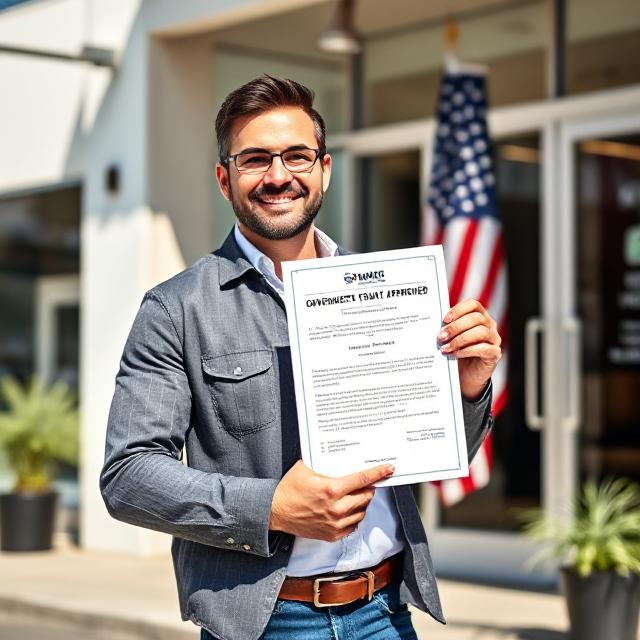
Introduction: Why Credit Matters in America
In the United States, your credit score affects almost every part of your financial life. From renting an apartment to getting approved for a car loan, credit plays a major role. Yet many Americans either have poor credit or none at all. If you’re just starting out or trying to fix your credit, a secured credit card is a powerful tool that can help. In this article, we’ll explore how to build credit with a secured credit card—step by step, in plain English, and with official resources to guide you.
What Is a Secured Credit Card?
A secured credit card works like a regular credit card, but it requires a refundable security deposit to open. That deposit acts as your credit limit. For example, if you deposit $300, your limit will typically be $300.
Unlike prepaid cards, secured cards report your activity to the major credit bureaus—Experian, Equifax, and TransUnion—helping you build a positive credit history.
According to the Consumer Financial Protection Bureau (CFPB), secured cards are often used by individuals new to credit or those with poor credit.
Step-by-Step: How to Build Credit with a Secured Credit Card
Let’s break it down into easy steps to make your credit-building journey smooth and successful.
Step 1: Check Your Credit Reports
Before applying, check if you already have any existing credit history. Even if you’ve never had a credit card, student loans or utility bills might show up.
- Get your free credit report from all three major credit bureaus via the official site:
AnnualCreditReport.com
As of now, you can access free weekly reports due to COVID-19 extensions.
Step 2: Choose the Right Secured Credit Card
Not all secured cards are the same. Choose a card that reports to all three bureaus, charges low or no annual fees, and offers an option to upgrade to an unsecured card after responsible use.
Key features to look for:
- No hidden fees
- Reasonable minimum deposit (usually $200–$300)
- Reports to all credit bureaus
- Path to upgrade or refund deposit
Check the CFPB’s credit card agreements database here:
CFPB Credit Card Agreements
Step 3: Make Your Deposit and Get Approved
Once you choose your card, you’ll submit your security deposit—which usually becomes your credit limit. For example, a $500 deposit = $500 spending limit.
- This deposit is refundable when you upgrade or close the account with a zero balance.
- Most issuers require proof of identity and income to prevent fraud.
Tip: Consider starting with a deposit you can comfortably manage.
Step 4: Use the Card Responsibly
The way you use your card affects your credit score more than anything else. Here’s how to use your secured card to maximize credit growth:
Make Small Purchases
- Use it for small, regular expenses like gas, groceries, or streaming services.
- Avoid maxing out the card; instead, use 30% or less of your credit limit.
Pay On Time, Every Time
- Set up automatic payments or reminders.
- Even one missed payment can hurt your credit score.
Learn more about how payment history affects your score at MyFICO (official FICO site)
Step 5: Monitor Your Credit Progress
Watch your score increase over time. Most secured cards offer free credit score tracking. You can also use free tools like:
- AnnualCreditReport.com (official site)
- Consumer.gov’s Credit Page
Your score won’t improve overnight, but 3–6 months of on-time payments and responsible use can show positive results.
Step 6: Upgrade or Apply for an Unsecured Credit Card
Once your credit score improves, you may:
- Request to upgrade your secured card to an unsecured card.
- Or, apply for a new unsecured card with better rewards and no deposit.
Good issuers will return your deposit and possibly increase your credit limit.
Make sure to close the secured card only after getting the new card to avoid a dip in your credit utilization ratio.
How a Secured Credit Card Affects Your Credit Score
Your credit score is based on five factors:
| Factor | Impact % |
|---|---|
| Payment History | 35% |
| Amounts Owed (Utilization) | 30% |
| Length of Credit History | 15% |
| Credit Mix | 10% |
| New Credit Inquiries | 10% |
Secured cards help build:
- Payment history (most important!)
- Credit utilization
- Length of history (over time)
More details on credit scoring models can be found at
USA.gov: Credit Reports and Scores
Example: A Success Story
Maria, 24, a recent college graduate, had no credit history. She opened a secured card with a $300 deposit and used it for groceries and Netflix. By making on-time payments for 6 months and keeping her balance low, her score went from 0 to 720.
She upgraded to an unsecured card, got her deposit refunded, and qualified for a car loan with a lower interest rate.
Mistakes to Avoid When Using a Secured Credit Card
1. Maxing Out Your Credit Limit
- Keep usage below 30% of your limit (ideal is 10%).
2. Late or Missed Payments
- Set up auto-pay or reminders. One missed payment can drop your score significantly.
3. Closing the Card Too Early
- Keep it open at least 6–12 months to build a solid history.
4. Applying for Too Many Cards at Once
- Each application causes a hard inquiry, which can lower your score temporarily.
Who Should Use a Secured Credit Card?
- Students or young adults with no credit
- Individuals recovering from bankruptcy
- Immigrants new to the U.S.
- Anyone trying to rebuild damaged credit
According to USA.gov, secured cards are one of the safest ways to establish credit.
Additional Government Resources
Here are more official links to guide you safely:
- Federal Trade Commission (FTC) – Building a Credit History
- Consumer Financial Protection Bureau – Credit Cards
- MyMoney.gov – Government-wide Financial Literacy Resource
- USA.gov – Manage Your Credit
Final Thoughts: Your Credit, Your Future
If you’re wondering how to build credit with a secured credit card, the answer is simple: be consistent, responsible, and patient. Secured credit cards are one of the most effective tools to get you started. With time and effort, you’ll unlock better financial opportunities—whether that’s getting approved for a mortgage, a car loan, or a better job (yes, some employers check credit!).
Start small, stay disciplined, and use the official resources we shared. Your credit score is like your financial reputation—take good care of it, and it will open doors for you.
TL;DR: Fast Recap
- Secured cards require a deposit but report to credit bureaus.
- Use under 30% of your limit and always pay on time.
- Choose cards that report to all 3 bureaus.
- Monitor your credit and upgrade after 6–12 months.
- Use gov links like consumerfinance.gov and annualcreditreport.com to track and protect your credit.
READ MORE:
- Top Internet Safety Tips You Should Know
- How to File Taxes for Free in the USA
- How to Apply for Section 8 Housing in the USA
- Government Grants for Small Businesses in the USA









1 comment on “Step-by-Step Guide: How to Build Credit with a Secured Credit Card in the USA”